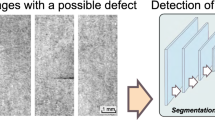Abstract
Automatic visual inspection has become one of the active research issues in machine vision technology in the past decades. Most of the methodologies developed address the problems of defect detection on a nontextured or regularly textured surface. However, problems in detecting defects on a randomly textured surface, especially cracks, have not received much attention. In this paper, we present a novel algorithm that uses a Wigner model to identify cracks in complex textural backgrounds, regardless of whether the inspected surface is randomly or regularly textured. We also investigate the windowing characteristics of the Wigner distribution and their impact on crack detection. Some of the Brodatz' natural texture images have been used for evaluating the performance of the algorithm. Promising results are obtained and presented in this paper.
Similar content being viewed by others
References
Bastiaans MJ (1978) The Wigner distribution function applied to optical signals and systems. Opt Commun 25:26–30
Bastiaans MJ (1979) Wigner distribution function and its application to first order optics. J Opt Soc Am 69:ccc-ccc
Campbell FW, Robson JG (1968) Application of Fourier analysis to the visibility of gratings. J Physiol 197:551–566
Claasen TACM, Mecklenbrauker WFG (1980) The Wigner distribution - a tool for time-frequency signal analysis; part 3: relations with other time frequency signal transformation. Philips J Res 35:372–398
D'astous A, Jernigan ME (1984) Texture discritmination based on detailed measures of the power spectrum. Proceedings of the 7th International Conference on Pattern Recognition 6:269–285
Daugman GF (1985) Uncertainty relatin for resolution in space, spatial frequency, and orientation optimized by two dimensional visual cortical filters. J Opt Soc Am 2:1160–1169
Flandrin P (1984) Some features of time frequency representation of multicomponent signals. Proceedings of the IEEE International Conference on Acoustics, Speech and Signal Processing, pp41B.41–41B.44
Hancock E, Kittler J (1990) Edge-labelling using dictionary relaxation. IEEE Patt Anal Machin Intell 12:165–181
Hubel DG, Wiesel TN (1962) Receptive fields, binocular interaction, and functional architecture in the cat's visual cortex. J Physiol London 160:106–154
Hubel DG, Wiesel TN (1974) Sequence regularity and geometry of orientation columns in the monkey striate cortex. J Comp Neurol 158:267–293
Jacobson L, Wechsler H (1982) The Wigner distribution and its usefulness for 2D image processing. Proceedings of the 6th International Joint Conference on Pattern Recognition, pp 19–22
Jacobson LD, Wechsler H (1988) Joint spatial/spatial-frequency representation. Signal Processing 14:37–68
Kaiser JF (1966) Digital filters. Wiley, New York
Maffei L, Fiorentini A (1973) The visual cortex as a spatial frequency analyzer. Vision Res 13:1255–1267
Martin W, Flandrin P (1984) Analysis of non-stationary process: short time periodograms versus a pseudo Wigner estimator. Schussler EURASI North Holland, Amsterdam, pp 455–459
Neisser U (1967) Cognitive psychology. Prentice Hall, Englewood cliffs, NJ
Petrou M (1993) Optimal convolution filters and an algorithm for the detection of linear features. IEE Proceedings Communications, Speech and Vision pp 331–339
Pollen DA, Lee JR, Tayor JH (1971) How does the striate cortex begin the reconstruction of the visual world. Science 173:74–77
Qian S, Morris JM (1992) Wigner distribution decomposition and cross-term deleted representation. Signal Processing 27:125–144
Reed TJ, Wechsler H (1990) Segmentation of textured images and gestalt organisation using spatial/spatial-frequency representations. IEEE Trans Patt Anal Machine Intell 12:1–11
Rosenfeld A, Hummel R, Zucker S (1976) Scene labelling by relaxation operations. IEEE Trans Syst Man Cybernetics 6:269–285
Slepian D (1965) Analytic solution of two apodizatin problems. J Opt Soc Am 55:1110–1115
Wechsler H (1990) Computational vision. Academic Press, New York
Weszka JS, Dyer CR, Rosenfeld A (1976) A comparative study of texture measures for terrain classification. IEEE Trans Syst Man Cybernetics 6:269–285
Zucker SW, Krishoamuthy EV, Harr RL (1978) Relaxation process for relaxation labelling convergence speed and stability. IEEE Trans Syst Man Cybernetics 8:41–48
Author information
Authors and Affiliations
Corresponding author
Rights and permissions
About this article
Cite this article
Song, K.Y., Petrou, M. & Kittler, J. Texture crack detection. Machine Vis. Apps. 8, 63–75 (1995). https://doi.org/10.1007/BF01213639
Issue Date:
DOI: https://doi.org/10.1007/BF01213639




